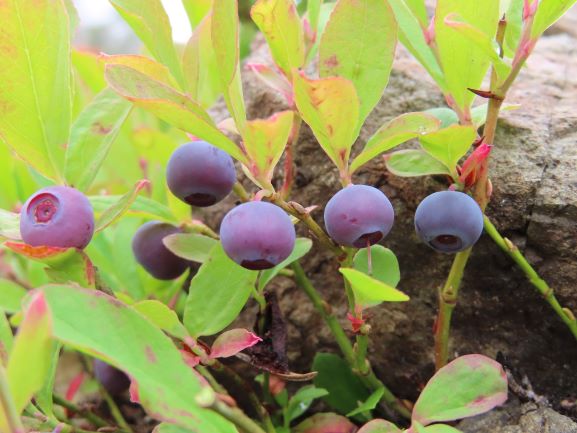On Monday, October 26 2020, Helen Haller Elementary kindergarten teacher Lorrie Corder will share some pumpkin craft ideas, and will talk about continuing to prepare children for kindergarten readiness.
For more parenting activities and skill building programs, visit the ClallamCountyBar.com Parenting Info page.
6, 8, 9, 12 (?) kinds of wild blueberries in the Olympics
How many varieties of wild blueberries are in the Olympics? (All blueberries are in the Vaccinium genus, a member of the heath family (Ericaceae).
6 are specifically identified by Doug Benoliel, author of Northwest Foraging: A guide to edible plants of the Pacific Northwest (1974). Red and blue huckleberries are vacciniums (Vaccinium parvifolium and Vaccinium membranaceum, respectively). Bog cranberry (Vaccinium oxycoccos) is too. The evergreen huckleberry (Vaccinium Ovatum) lives in the coastal forests, makes a lovely ornamental plant, and never loses its leaves. Doug identifies Grouseberry (Vaccinium scoparium), or whortleberry, as being in the blueberry family, but its probably only in the Cascade mountains, not the Olympics. Perhaps the tastiest of them all is the Oval-leaved blueberry (Vaccinium ovalifolium), and its berries are sweetest on the bushes which have been eaten down to a few inches high by the deer and bear (as seen in the picture above when the leaves turn color in August-October).
8 according Douglas Deur, in his book Pacific Northwest Foraging (2014). He identifies the lingonberry (Vaccinium vitis-idaea) as a type of cranberry. He uniquely describes the Alaska Blueberry (Vaccinium alaskaense). Like Doug Benoliel, he describes the oval-leafed blueberry (above) with the same Latin name, Vaccinium ovalifolium. He also describes the bog huckleberry (Vaccinium uliginosum) which he describes as being one of the sweetest blueberries (contrary to Doug Benoliel’s claim about the oval-leaved blueberry).
9 according to Mark Turner and Phyllis Gustafson, authors of Wildflowers of the Pacific Northwest (2006), however, they describe three scientific names Douglas Deur does not, while Douglas Deur describes two that Turner and Gustafson do not. Oh, boy, this is getting confusing.
Turner and Gustafson identify the Alaska huckleberry but spell the scientific name a little different (Vaccinium alaskense). These authors claim a variant of the Alaska huckleberry is Vaccinium ovalifolium, which Doug Benoliel and Douglas Deur describe as the oval-leaved blueberry (same scientific name). Turner and Gustafson also claim there is a Cascades blueberry which has two variants, Vaccinium caespitosum, and the larger variety as Vaccinium deliciosum. Deliciosum as in Latin for delicious! (Is that one the best?)
One of the best books to identify Olympic Flowers, and to take hiking, is Charles Stewart’s Wildflowers of the Olympics and Cascades (1988). While he does a nice job with plant descriptions, pictures, and a brief historical note about most plants, he doesn’t identify every flower or berry. He does identify two Vacciniums. He describes the oval-leaf huckleberry (Vaccinium ovatum). He calls Vaccinium Deliciosum the blue-leaf huckleberry (is that the best?).

12+ types of “blueberries”
So how many different types of blueberries are there in the Olympics? Doug Benoliel actually states there are more than 12 different types in the pacific northwest. They are so similar which is why they are placed in the same genus of Vaccinium. Like other plants and animals that are very similar, botanists sometimes disagree on whether a specific plant is a different species, or a sub-variety. That may explain why Vaccinium ovilifolium, Vaccinium uliginosum, or Vaccinium deliciosum actually all describe the same plant, two or even three different plants. However you count them, there’s a lot of wild blue-black-red-orange Vaccinium berries up in them there hills. Most become ripe in July, August, and September (depending on variety and elevation). Finding, identifying, and eating wild blueberries is a great nature experience for kids, and an excellent SNACCMS activity for building moral fiber.
Cautionary notes:
Ripe berries are pretty easy to identify as being in the blueberry family once you get a sense of what a blueberry bush is like. All the blue and black berry varieties taste like a blueberry. To be certain, the best way to identify edible plants is usually by the flower description, using a good guide book. Charles Stewart’s and Doug Benoliel’s books are easy to slip into a day pack.
The blueberries on the very short plants, 2-6 inches tall are the sweetest, probably because they have been “pruned”, or eaten down, by the deer and bear. perhaps their root systems are strong and the plants can concentrate a lot of energy into a few berries. You’ll often notice deer and bear scat near these plants, so there may be a risk these berries have been exposed to other animal excrements. Washing before eating might be advisable.
| 11 Vacciniums are identified by the authors of the the four books listed above |
| Vaccinium alaskaense (or alaskense) Vaccinium caespitosum Vaccinium deliciosum Vaccinium membranaceum Vaccinium ovalifolium Vaccinium Ovatum Vaccinium oxycoccos Vaccinium parvifolium Vaccinium scoparium Vaccinium uliginosum Vaccinium vitis-idaea |
What do you think? Are the authors correct? Have they misidentified some of the plants? Do you know other’s? Please drop us a note if you have anything to add.
First teacher online activities
Please join and share your questions and experiences, and invite your children to ask questions and get involved). A Zoom link will be available at First Teacher’s Facebook page, https://www.facebook.com/FirstTeacherPMF.
First Teacher online parent-child Zoom activities are free to parents and children in Port Angeles, Sequim, Clallam Bay, Neah Bay, Forks, and anywhere in Clallam County. These activities will offered weekly during the coronavirus times. Check back for upcoming sessions. Contact First Teacher if you would like to host a Zoom activity.
First Teacher is a service of the nonprofit Parenting Matters Foundation.
Law is an important service to the health of our community. Parenting is even more important.
